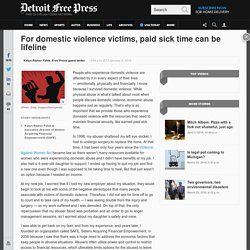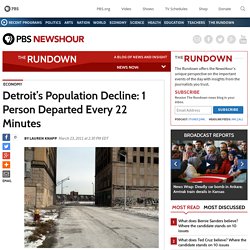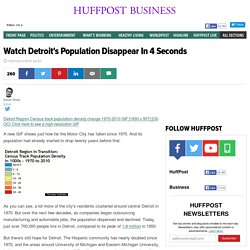

Detroit schools are in financial crisis and won’t be able to pay teachers after April 8. The ceiling is crumbling in this room at Ron Brown Academy, an elementary school in Detroit.

(Detroit Federation of Teachers) The Detroit public school system is running out of cash so quickly that it likely will not be able to make payroll after April 8 unless state lawmakers take action soon, the new state-appointed emergency manager said Wednesday. Detroit named most miserable U.S. city in Forbes ranking. For domestic violence victims, paid sick time can be lifeline. People who experience domestic violence are affected by it in every aspect of their lives — emotionally, physically and financially.

I know because I survived domestic violence. While physical abuse is what’s talked about most when people discuss domestic violence, economic abuse happens just as regularly. That’s why is so important that we provide those who experience domestic violence with the resources that need to maintain financial security, like earned paid sick time. In 1998, my abuser shattered my left eye socket. I had to undergo surgery to replace the bone.
At my new job, I worried that if I told my new employer about my situation, they would begin to look at me with some of the negative stereotypes that many people associate with victims of domestic violence. I never recognized how big of a role economic abuse plays in domestic violence until I experienced it firsthand. Domestic violence doesn’t just affect the person being abused either. Read or Share this story: Detroit's population loss slows; some suburbs see gains. Detroit continues to lose residents, but the population loss appears to be slowing, with about 1% moving out between 2013 and 2014, according to estimates released today by the U.S.

Census Bureau. Detroit Population Down 25 Percent, Census Finds. Detroit's Population Crashes. Detroit's Population Decline: 1 Person Departed Every 22 Minutes. Tuesday’s release of the 2010 census data showed a dramatic decline in Detroit’s population.

Over the past 10 years, the city lost a quarter of its residents, bringing it down to a size similar to the pre-auto boom numbers of 1910. In fact, Michigan’s was the only state population to decline between 2000 and 2010. Sarah Hulett, a reporter from Michigan Radio who covers Detroit, said that while many were expecting a drop in population, “what is a surprise, I think to a lot of people, is just how steep the drop has been.”
The current emigration rate means one person left the city every 22 minutes between 2000 and 2010. Sarah Hulett of Michigan Radio talks to Hari Sreenivasan: Detroit’s white population rises. Detroit’s white population rose by nearly 8,000 residents last year, the first significant increase since 1950, according to a Detroit News analysis of U.S.

Census Bureau data. The data, made public Wednesday, mark the first time census numbers have validated the perception that whites are returning to a city that is overwhelmingly black and one where the overall population continues to shrink. Many local leaders contend halting Detroit’s population loss is crucial, and the new census data shows that policies to lure people back to the city may be helping stem the city’s decline. “It verifies the energy you see in so many parts of Detroit and it’s great to hear,” said Kevin Boyle, a Pulitzer Prize-winning author and historian who studies the intersection of class, race, and politics in 20th-century America.
Watch Detroit's Population Disappear In 4 Seconds. A new GIF shows just how far the Motor City has fallen since 1970.

And its population had already started to drop twenty years before that. World Population Statistics. How did Detroit fall into the abyss? The bankruptcy filing for Detroit marks a final step in the chrome-plated city’s decades-long decline – which started with the country’s overall manufacturing slowdown and continued with the departure of U.S. automakers and residents, leaving behind a sprawling city trying to survive on dwindling coffers.

Detroit was in the 1950s a worldwide hub of auto manufacturing, making it the fourth-largest U.S. city with one of the country’s highest per-capita incomes. However, the so-called Motor City’s decline started soon after with residents -- following their counterparts in other U.S. cities – starting to move to the suburbs and take with them businesses, jobs and tax dollars. Detroit city Michigan QuickFacts from the US Census Bureau"> Detroit Population 2016 - World Population Review. Detroit, the most populous city in Michigan and the Metro Detroit area, serves as a major port connecting the Great Lakes to the Saint Lawrence Seaway.

Detroit is also known as the traditional automotive center of the world and its name is synonymous for the US auto industry, as well as its musical legacies, which have earned it the nicknames Motor City and Motown. As of 2016, Detroit's estimated population is just over 677,000, a steep decline from a peak of over 1.8 million in the 1950s. Detroit Decline Causes Include Auto Industry Collapse, Segregation And Politics. -- Blue-collar workers poured into the cavernous auto plants of Detroit for generations, confident that a sturdy back and strong work ethic would bring them a house, a car and economic security.

It was a place where the American dream came true. It came true in cities across the industrial heartland, from Chicago's meatpacking plants to the fire-belching steel mills of Cleveland and Pittsburgh. It came true for decades, as manufacturing brought prosperity to big cities in states around the Great Lakes and those who called them home. Detroit was the affluent capital, a city with its own emblematic musical sound and a storied union movement that drew Democratic presidential candidates to Cadillac Square every four years to kick off campaigns at Labor Day rallies. The good times would not last forever. All of the nation's industrial cities fell, but only Detroit hit bottom. More affluence followed in the late 1940s and early 1950s as the auto industry was booming.
Getty Images.